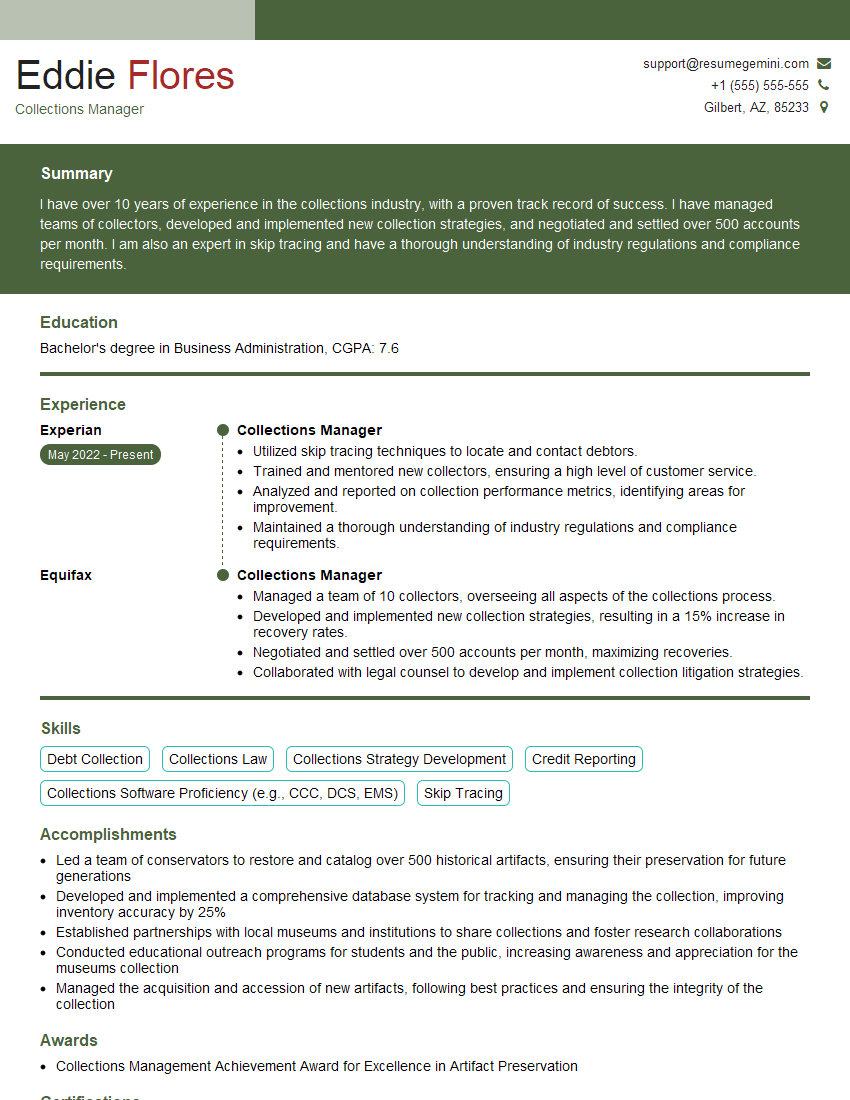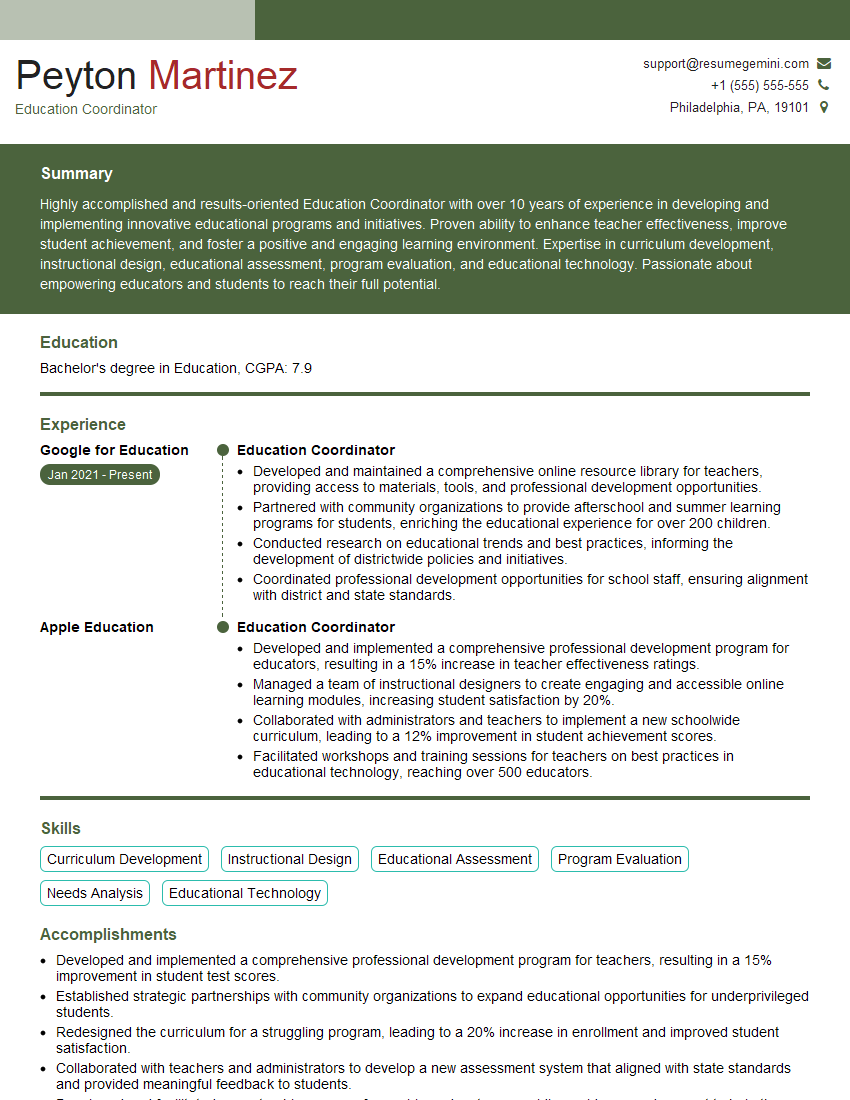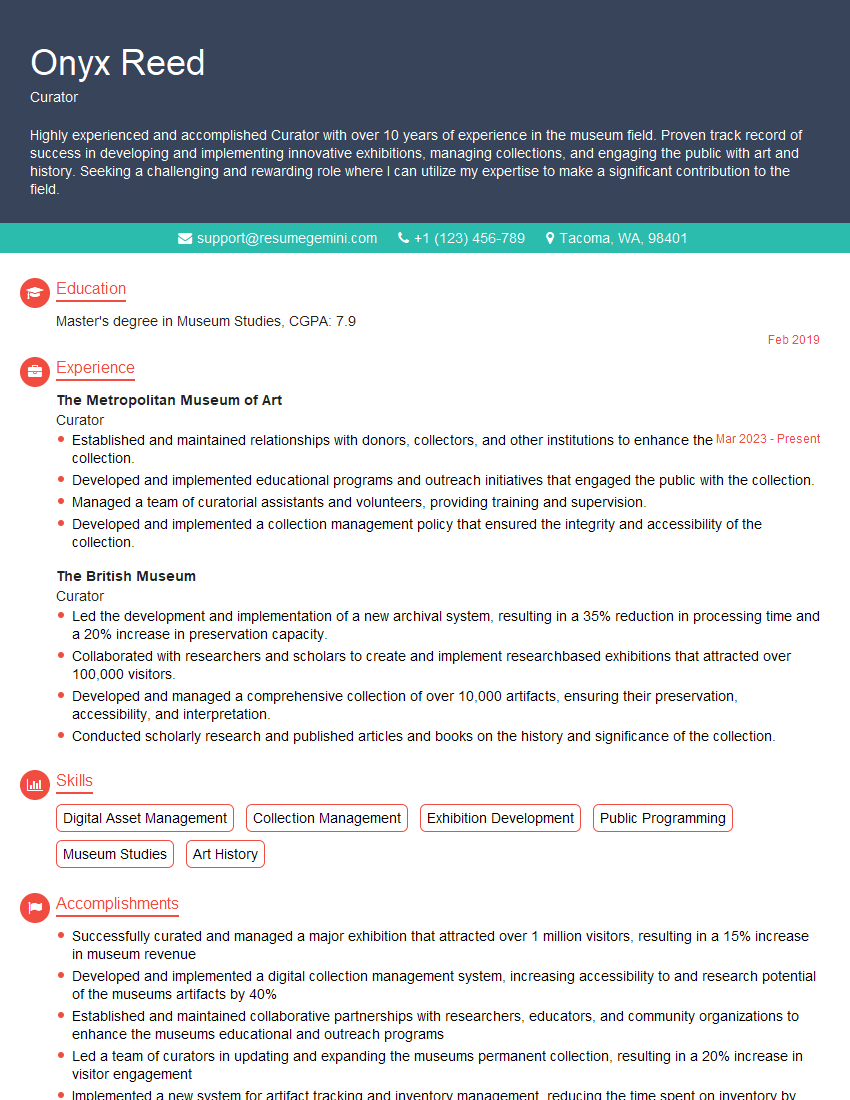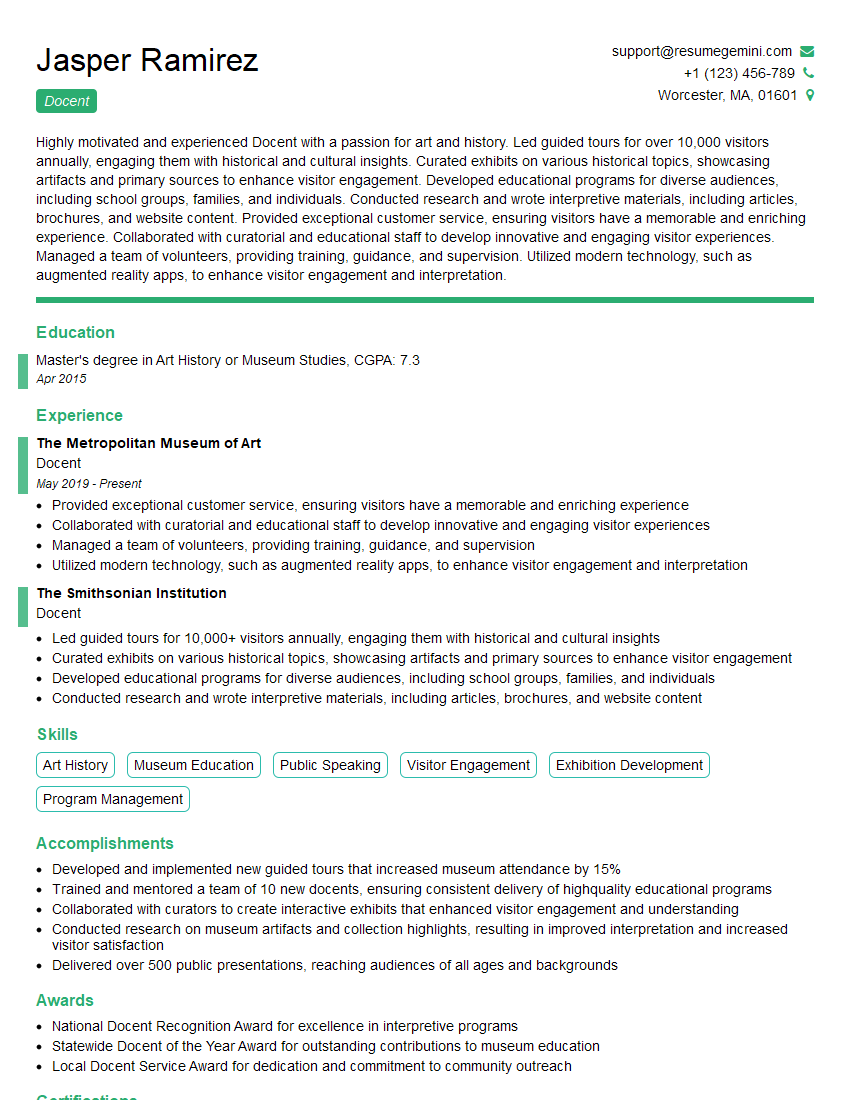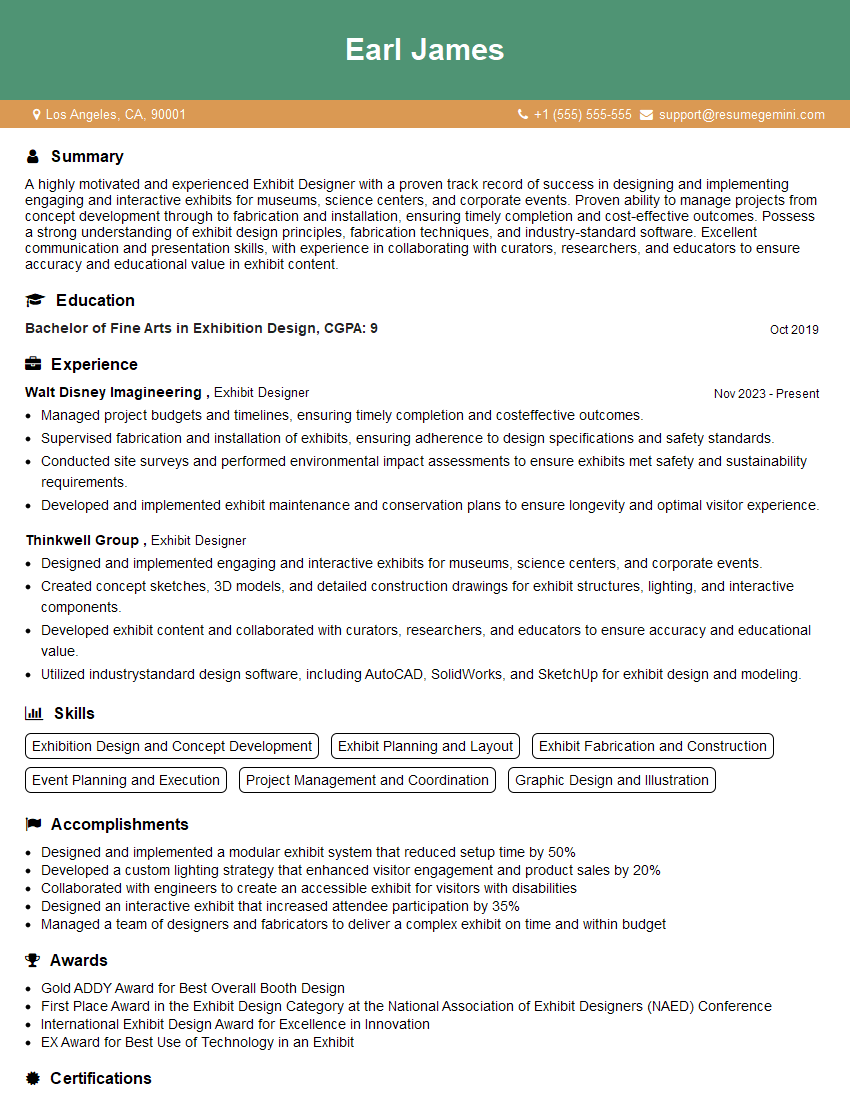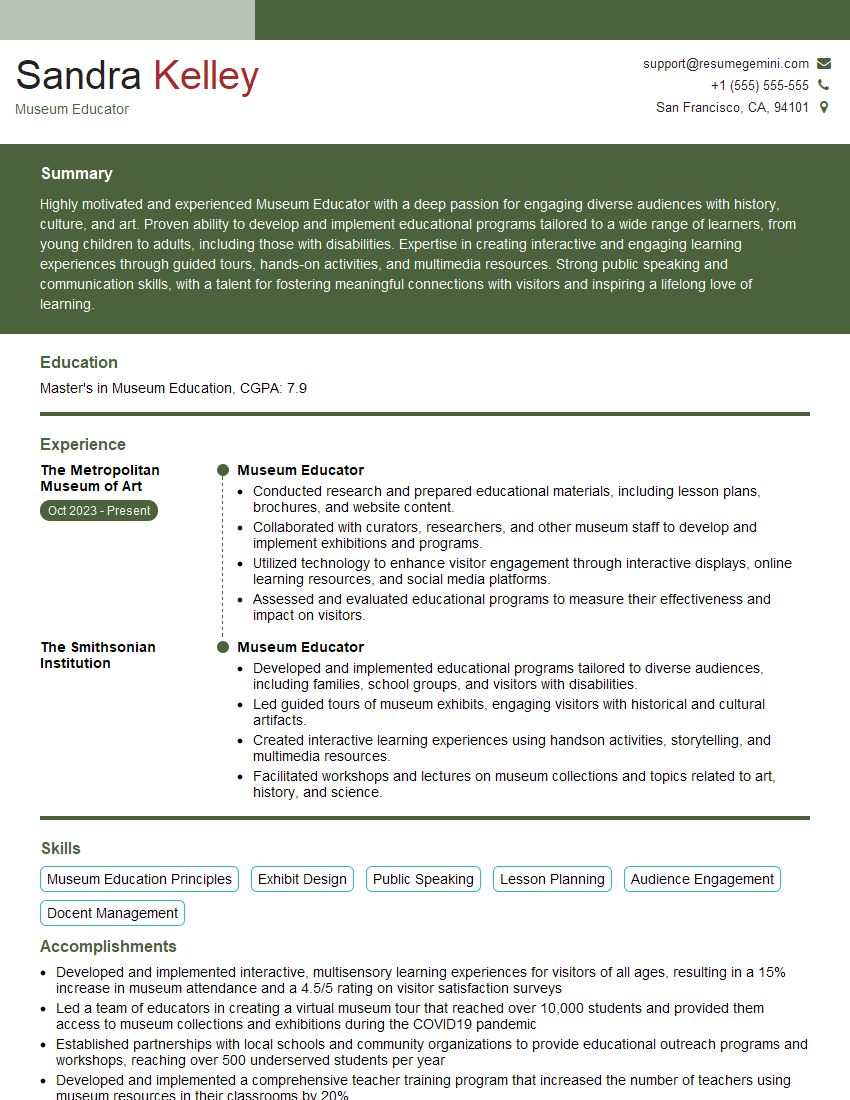The thought of an interview can be nerve-wracking, but the right preparation can make all the difference. Explore this comprehensive guide to Exhibit Interpretation interview questions and gain the confidence you need to showcase your abilities and secure the role.
Questions Asked in Exhibit Interpretation Interview
Q 1. Explain the difference between interpretation and education in a museum context.
Museum education and interpretation, while intertwined, have distinct goals. Education focuses on imparting factual knowledge and skills, often through formal learning methods like lectures or workshops. Think of a school field trip where students learn specific dates and facts about a historical period. Interpretation, however, aims to create meaningful connections between the exhibit and the visitor’s existing knowledge and experiences. It fosters understanding and appreciation, not just memorization. A good interpretive approach might use evocative storytelling to reveal the human stories behind historical events, enabling visitors to emotionally connect with the past rather than simply remembering dates.
For example, an educational approach to a dinosaur exhibit might focus on the scientific classification of different species. An interpretive approach would weave a narrative around a specific dinosaur’s life, exploring its environment, diet, and the challenges it faced, making the information more engaging and memorable.
Q 2. Describe your experience developing interpretive panels for museum exhibits.
I’ve had extensive experience designing interpretive panels for various museum exhibits. My process begins with thorough research into the exhibit’s theme and target audience. I collaborate closely with curators and designers to ensure the panels align with the overall exhibit narrative. I prioritize clear, concise language and visually compelling design elements like photographs, illustrations, and maps. For a recent exhibit on local indigenous cultures, I incorporated traditional storytelling techniques into the panel design, including quotes from elders and visually striking representations of their artwork. This approach moved beyond simple factual information to create an immersive and culturally sensitive experience.
A key aspect of my work is ensuring the information is accessible and engaging for a diverse range of visitors. I carefully consider font size, layout, and the use of multilingual labels. I also incorporate interactive elements wherever possible to encourage participation and deeper engagement. For instance, in an exhibit on the history of transportation, I included a touch screen interface that allowed visitors to explore different types of vehicles through interactive timelines and 3D models.
Q 3. How do you ensure accessibility in your exhibit interpretation strategies?
Accessibility is paramount in my interpretation strategies. This goes beyond simply providing large-print materials. I incorporate multiple sensory modalities, considering visitors with visual, auditory, cognitive, and physical impairments. For the visually impaired, I use tactile elements, braille, and audio descriptions. For the hearing impaired, I include captions and transcripts of audio-visual content. Clear and concise language, avoiding jargon, is crucial for all visitors. I also employ universal design principles, creating an exhibit that is enjoyable and informative for everyone, regardless of their abilities. For example, I would ensure appropriate spacing between panels to allow wheelchair access, and implement a variety of media like videos and interactive screens to cater to different learning styles.
Q 4. What are the key principles of effective exhibit interpretation?
Effective exhibit interpretation hinges on several key principles: Relevance: connecting the exhibit to visitors’ lives and interests; Clarity: presenting information in a concise, easy-to-understand manner; Accuracy: ensuring factual correctness; Engagement: utilizing interactive elements and compelling storytelling to capture visitor attention; Authenticity: representing cultural heritage respectfully and accurately; and Accessibility: ensuring inclusivity for all visitors. Failing to consider any of these principles can significantly hamper a visitor’s experience and understanding.
Q 5. How do you tailor your interpretation to different target audiences?
Tailoring interpretation to different audiences requires a nuanced understanding of their needs and interests. I conduct thorough audience research to determine the best communication approach. For example, an exhibit about science would require different language and presentation styles for children versus adults or for a general public versus university students. I would adjust the complexity of the language, length of text, and choice of imagery to match the audience’s age, background and prior knowledge. For children, I might incorporate playful activities and interactive games, while for adults, I might use more in-depth analysis and sophisticated visuals. I also consider cultural backgrounds, ensuring the interpretation resonates with various cultural perspectives and avoids unintentionally offensive content.
Q 6. Describe your experience working with diverse cultural perspectives in exhibit development.
My experience with diverse cultural perspectives has been instrumental in my work. I approach each project with a deep respect for the cultural heritage being represented. This includes working closely with community members and cultural experts to ensure accurate and sensitive representation. For a recent exhibit on immigration history, I collaborated extensively with immigrant communities, incorporating their personal stories and artwork to enrich the narrative. This collaborative approach avoids stereotypical portrayals and ensures the exhibition reflects the richness and complexity of their lived experiences. I always strive to avoid cultural appropriation and actively promote respectful dialogue and understanding.
Q 7. How do you evaluate the success of an interpretive program?
Evaluating the success of an interpretive program involves a multifaceted approach. Quantitative methods, such as visitor surveys and attendance figures, provide valuable insights into visitor satisfaction and engagement. Qualitative methods, like focus groups and informal observations, offer richer data on visitor understanding and emotional responses to the exhibit. Analyzing feedback from diverse groups helps identify areas for improvement and refine future interpretive strategies. Tracking how visitors interact with interactive elements provides data on their interest and learning. For example, if a touchscreen is rarely used, it indicates that element needs to be revised to improve its appeal. Ultimately, success is measured by how effectively the interpretation fosters understanding, appreciation, and emotional connection with the exhibit’s content.
Q 8. How do you incorporate interactive elements into exhibit interpretation?
Interactive elements are crucial for engaging visitors and fostering deeper understanding in exhibits. They transform passive observation into active learning.
My approach involves incorporating a variety of interactive elements, tailored to the exhibit’s theme and target audience. This might include:
- Touch screens and kiosks: Offering multimedia content, interactive maps, or quizzes.
- Augmented reality (AR) applications: Overlay digital information onto the real world, enhancing visitor experience through visualizations and animations. For example, an AR app could allow visitors to see a 3D model of a dinosaur superimposed on its fossil.
- Hands-on activities: These could range from simple puzzles related to the exhibit’s topic to more complex experiments or simulations. For a geology exhibit, this might involve handling different types of rocks and minerals to understand their properties.
- Interactive games and challenges: Gamification can make learning fun and encourage participation. A history exhibit could incorporate a strategy game based on historical events.
- Audio-visual installations: Using dynamic videos, soundscapes, and interactive projections to bring the exhibit to life. For example, a nature exhibit might showcase a soundscape of a rainforest.
The key is to ensure interactivity is purposeful and enhances the learning experience, not just a gimmick.
Q 9. Explain your process for researching and writing exhibit content.
My research and writing process for exhibit content is rigorous and iterative. It begins with a deep dive into the subject matter. This involves:
- Extensive research: I consult primary and secondary sources—books, academic journals, archival materials, museum collections, interviews with experts—to ensure accuracy and depth.
- Defining the target audience: Understanding their knowledge level, interests, and learning styles is crucial for tailoring the content effectively. This influences vocabulary, tone, and the complexity of information presented.
- Developing a narrative arc: I craft a compelling storyline that engages the visitor from start to finish. This might be chronological, thematic, or problem-solving, depending on the exhibit’s goals.
- Outlining and writing drafts: Clear, concise, and engaging writing is vital. I focus on active voice, strong verbs, and relatable language. I also strive for inclusivity and avoid jargon wherever possible.
- Review and revision: Peer review and feedback from subject matter experts are incorporated to ensure factual accuracy and clarity. I often test drafts with potential visitors to gather feedback and refine the content.
Throughout the process, I maintain a detailed record of sources and ensure all claims are well-supported.
Q 10. How do you balance factual accuracy with engaging storytelling in exhibit interpretation?
Balancing factual accuracy and engaging storytelling is the core challenge—and the art—of exhibit interpretation. It’s not about choosing one over the other but skillfully weaving them together.
I approach this by:
- Focusing on a compelling narrative: Even complex scientific or historical information can be presented through a story, drawing visitors in and making information more memorable.
- Using evocative language and visuals: Images, objects, and audio-visual elements can convey information more powerfully than text alone, making the exhibit more accessible and engaging.
- Employing storytelling techniques: Techniques like character development, conflict, and resolution can be applied to the presentation of information, enhancing its emotional impact.
- Using clear and concise language: Avoid overwhelming the visitor with too much technical detail. Simplify complex concepts without sacrificing accuracy.
- Including interactive elements: Interactive components allow visitors to actively engage with the material, making it more memorable and easier to understand.
For example, in an exhibit about climate change, I might use a compelling narrative of a community facing its effects, then use data and graphs to illustrate the wider problem, and finally incorporate interactive elements that allow visitors to explore solutions.
Q 11. Describe a time you had to adapt your interpretation plan due to unexpected circumstances.
During the development of a traveling exhibit on early American settlements, we faced an unforeseen issue: a key artifact was damaged in transit. It was a pivotal piece, central to the narrative.
We had to adapt quickly. Our team held an emergency meeting to brainstorm solutions. We couldn’t replace the artifact in time. Our solution involved a multi-pronged approach:
- Re-writing relevant sections of the exhibit text: We focused on the context and significance of the missing artifact, explaining the damage and emphasizing its importance without relying solely on its physical presence.
- Creating a high-quality digital replica: A 3D model was created and displayed on a nearby touch screen kiosk, allowing visitors to still “examine” the artifact virtually.
- Incorporating a section detailing the conservation and challenges of preserving artifacts: This transformed a setback into an educational opportunity, highlighting the behind-the-scenes work of museum professionals.
- Adding supplemental digital resources: Visitors could access high-resolution images and detailed information about the artifact online through a QR code.
While unexpected, this situation allowed us to showcase adaptability and resilience, and creatively address the situation. The visitor response was positive, demonstrating the importance of flexibility and creative problem-solving in exhibit interpretation.
Q 12. How familiar are you with different interpretive methodologies (e.g., thematic, chronological)?
I’m highly familiar with various interpretive methodologies. The choice of methodology depends heavily on the exhibit’s topic, goals, and target audience.
- Thematic Interpretation: Organizes information around central themes or concepts. This approach is excellent for highlighting connections and relationships between diverse elements. For example, an exhibit about the American Revolution might use themes like liberty, resistance, and the consequences of war.
- Chronological Interpretation: Presents information in a linear timeline, suitable for historical exhibits or those showcasing evolutionary processes. An exhibit about the history of flight would lend itself well to this method.
- Biographical Interpretation: Centers on the life and achievements of a specific person or group. A museum showcasing the work of a famous artist would use this method effectively.
- Geographic Interpretation: Organizes information based on location. An exhibit focusing on different ecosystems or historical settlements would employ this approach.
- Problem-Solving Interpretation: Presents a problem or challenge and guides visitors through different solutions or perspectives. An exhibit on climate change could use this structure to explore causes and solutions.
Often, a combination of methodologies proves most effective. A well-designed exhibit might use thematic organization within a chronological framework, for instance.
Q 13. How do you incorporate technology into your interpretation strategies?
Technology plays a vital role in enhancing the visitor experience and making exhibits more accessible and engaging. I integrate technology strategically to avoid overwhelming the visitor.
- Interactive touchscreens and kiosks: Providing multimedia content, interactive maps, and quizzes.
- Augmented reality (AR) and virtual reality (VR): Offering immersive experiences that bring history, science, or art to life. Imagine an AR app that overlays information about historical buildings onto a city map in a museum.
- Digital projections and video displays: Showcasing dynamic visuals, animations, and storytelling elements.
- Audio guides and podcasts: Delivering rich audio content that enriches the visitor experience.
- QR codes and mobile apps: Providing access to supplementary information, interactive games, and further exploration.
- Data visualization tools: Representing complex data in visually compelling ways.
The key is to use technology thoughtfully and purposefully, ensuring it enhances the educational experience rather than distracting from it. Technology should support the narrative and interpretive goals of the exhibit, not overshadow them.
Q 14. What are some common challenges in exhibit interpretation, and how do you address them?
Exhibit interpretation faces several common challenges:
- Balancing accessibility and accuracy: Making complex information understandable to a diverse audience without sacrificing accuracy requires careful planning and clear communication.
- Engaging visitors with limited attention spans: Competing for visitors’ attention requires creating dynamic and engaging exhibits that hold their interest.
- Managing diverse learning styles and needs: Catering to visitors with different backgrounds, learning preferences, and accessibility requirements is essential.
- Keeping exhibits up-to-date: New research and discoveries can quickly render exhibit information outdated. Regular review and revision are necessary to maintain accuracy and relevance.
- Budgetary constraints: Balancing creative goals with available resources often presents a significant hurdle.
I address these challenges through:
- Thorough audience research: Understanding the needs and interests of the target audience guides decisions about content, design, and interactive elements.
- Strategic use of technology: Interactive elements and multimedia can enhance engagement and cater to diverse learning styles.
- Collaboration with experts: Subject matter specialists and designers contribute valuable insights and expertise.
- Iterative design process: Testing and refining designs based on visitor feedback and evaluations is crucial.
- Prioritizing clear communication: Simple language, compelling storytelling, and effective visuals are essential for conveying complex information.
Q 15. How do you ensure the visual design of an exhibit supports its interpretive goals?
Ensuring visual design supports interpretive goals requires a deep understanding of both aesthetics and communication. It’s not just about making an exhibit look good; it’s about using visuals to tell a story and achieve specific learning objectives. This involves a close collaboration between exhibit designers and interpreters.
- Clear Hierarchy of Information: Visual cues like size, color, and placement guide the visitor’s eye. Important information should be prominently displayed, while less crucial details can be subtly integrated. For instance, a large, striking image might introduce a key concept, followed by smaller panels providing supporting details.
- Color Palette and Typography: These elements directly impact readability and mood. A carefully chosen color palette can enhance the theme and highlight key elements, while clear typography ensures easy reading and accessibility for all visitors. Imagine using warm colors to convey a sense of comfort in a historical exhibit on home life, contrasted with cooler tones for a section on challenges faced.
- Interactive Elements: Visual design should seamlessly integrate interactive elements such as touchscreens, audio stations, and physical models. These elements shouldn’t be distractions but should complement the overall narrative flow, enriching the visitor experience.
- Consistent Branding: Maintaining a consistent visual style throughout the exhibit ensures a cohesive and professional presentation. This includes consistent use of logos, fonts, colors, and image styles, creating a unified experience that aids understanding and memorability.
For example, in an exhibit about the Amazon rainforest, vibrant imagery of the flora and fauna is essential, but these visuals must be carefully integrated with text panels explaining conservation efforts. Poor design could overwhelm visitors with information or make the exhibit feel chaotic. Careful planning ensures the visual elements support the educational aims.
Career Expert Tips:
- Ace those interviews! Prepare effectively by reviewing the Top 50 Most Common Interview Questions on ResumeGemini.
- Navigate your job search with confidence! Explore a wide range of Career Tips on ResumeGemini. Learn about common challenges and recommendations to overcome them.
- Craft the perfect resume! Master the Art of Resume Writing with ResumeGemini’s guide. Showcase your unique qualifications and achievements effectively.
- Don’t miss out on holiday savings! Build your dream resume with ResumeGemini’s ATS optimized templates.
Q 16. Describe your experience in collaborating with exhibit designers and other professionals.
My experience collaborating with exhibit designers and other professionals is extensive. I’ve worked with teams including graphic designers, architects, multimedia specialists, and educators. I believe in a participatory design process where open communication and shared decision-making are key.
- Early Collaboration: My approach involves joining the design process from the initial concept stage, ensuring the interpretive goals are incorporated from the outset. This avoids costly redesigns later on.
- Shared Goals and Regular Communication: I foster a culture of transparent communication through regular meetings and reviews. Sharing sketches, prototypes, and feedback is integral to ensuring the interpretive plan and visual design are aligned.
- Respect for Expertise: I respect the unique contributions of each team member. I leverage the designers’ expertise in visual communication while offering my expertise in interpretation and audience engagement. This collaborative approach ensures the exhibit meets both aesthetic and educational standards.
- Iterative Process: We use an iterative process, testing and revising designs based on feedback from usability testing and pilot programs. This allows us to refine the exhibit until it truly meets its goals.
For instance, in a recent project on local history, I worked closely with a graphic designer to develop a compelling visual narrative using archival photographs. My understanding of the historical context informed the selection and presentation of the images, while the designer’s skill ensured aesthetic appeal.
Q 17. How do you handle visitor inquiries or questions that fall outside your expertise?
When visitors ask questions outside my expertise, honesty and resourcefulness are paramount. I never pretend to know something I don’t.
- Acknowledge Limitations: I politely acknowledge that I don’t have the answer, but express my willingness to help them find it.
- Direct to Relevant Resources: I direct them to appropriate resources like books, websites, or other staff members who possess the relevant expertise. This could involve guiding them to a specific section within the exhibit or connecting them with a subject matter expert.
- Follow-up if Possible: Where appropriate, I offer to follow up on their question and provide an answer later. This demonstrates attentiveness and a commitment to visitor satisfaction.
- Learn from the Experience: Such encounters highlight gaps in the exhibit’s interpretive plan or areas where additional information might be needed. This feedback informs future improvements.
For example, if a visitor asked about a specific technical detail in a science exhibit, I would direct them to a scientific journal or perhaps to an expert in the museum’s science department. This demonstrates professionalism and ensures visitors feel valued even when their questions exceed my specific knowledge base.
Q 18. How do you assess the needs of different visitors and adjust your approach accordingly?
Understanding diverse visitor needs is fundamental to effective interpretation. I cater to varying levels of prior knowledge, learning preferences, and physical abilities.
- Targeted Content: I develop content that caters to different age groups and knowledge levels. This might include different levels of detail in exhibit labels or providing multiple access points to information.
- Varied Media: I incorporate a variety of media—text, images, audio, video, interactive displays—to cater to different learning styles. Some visitors prefer visual learning, while others are more auditory or kinesthetic learners.
- Accessibility Considerations: I ensure accessibility for visitors with disabilities by incorporating elements like large print labels, audio descriptions, tactile displays, and wheelchair-accessible pathways.
- Pre-visit Materials: Consider offering pre-visit materials online or in brochures that cater to diverse groups and allows visitors to prepare for their experience.
In a children’s museum exhibit on dinosaurs, for instance, I would use simple language and engaging visuals for younger children, while providing more in-depth information and scientific terminology for older visitors. This ensures everyone finds the exhibit relevant and engaging at their own level.
Q 19. Describe your experience working with diverse learning styles and abilities.
My experience working with diverse learning styles and abilities has taught me the importance of offering multiple pathways to understanding. I believe that effective interpretation needs to engage visitors with various cognitive styles.
- Visual Learners: I leverage strong visuals, including images, diagrams, and interactive maps, to enhance comprehension for visual learners.
- Auditory Learners: Audio tours, oral presentations, and sound installations cater to auditory learners.
- Kinesthetic Learners: Hands-on activities, interactive simulations, and physical models engage kinesthetic learners.
- Cognitive Differences: I focus on clear and concise language, avoiding jargon and complex sentence structures. I use visual cues and simplified layouts to support visitors with cognitive differences or dyslexia.
In an exhibit on ancient civilizations, I might include a tactile replica of an artifact for visually impaired visitors, an audio tour narrating the history, and interactive timelines for those who prefer visual-spatial learning.
Q 20. How do you ensure that your interpretation is inclusive and avoids perpetuating stereotypes?
Creating inclusive interpretation requires careful consideration of language, imagery, and the overall narrative. I aim to present diverse perspectives accurately and avoid perpetuating stereotypes.
- Diverse Representation: I strive for accurate and balanced representation of diverse groups in the exhibit’s content. This includes images, artifacts, and stories that reflect the experiences of various cultures, ethnicities, and genders.
- Careful Language: I use inclusive language that avoids gendered or culturally biased terms.
- Community Consultation: I engage with communities represented in the exhibit to ensure their stories are told authentically and respectfully. This often involves seeking input from community members in the planning and development phases.
- Sensitivity to Cultural Differences: I always maintain sensitivity to cultural differences and avoid the appropriation or misrepresentation of cultural practices.
For example, when developing an exhibit on immigration, I would seek input from immigrant communities and ensure a balanced representation of diverse immigrant experiences—both challenges and triumphs—avoiding generalizations or stereotypes.
Q 21. How do you use evaluation data to inform future interpretive planning?
Evaluation data plays a crucial role in informing future interpretive planning. It helps us understand what works, what doesn’t, and how to improve future exhibits.
- Visitor Surveys: I collect visitor feedback through surveys to assess their understanding, engagement, and overall satisfaction.
- Observation Studies: I use observation methods to understand how visitors interact with the exhibit and identify areas of confusion or disinterest. This often involves observing visitors’ movement, behavior and interactions.
- Usage Data: Analyzing data such as attendance figures, website traffic (if applicable), and touchscreen usage allows us to measure the effectiveness of different exhibit components.
- Focus Groups: Holding focus groups with target audiences provides qualitative data about their opinions and preferences.
- Iterative Improvements: This data is crucial for iterative improvements to future exhibits. We use this information to refine content, improve design, and enhance the overall visitor experience.
For instance, if visitor surveys reveal that a particular section of an exhibit is poorly understood, it might prompt us to revise the language, add visuals, or rearrange the layout in future iterations. This ensures continuous improvement based on concrete evidence.
Q 22. What software or tools are you proficient in using for exhibit development or interpretation?
Proficiency in exhibit development software is crucial. My skillset encompasses a range of tools, from Adobe Creative Suite (Photoshop, Illustrator, InDesign) for graphic design and layout to SketchUp and other 3D modeling software for creating interactive exhibit components. I’m also experienced with content management systems (CMS) like WordPress for managing digital components of exhibits and have used various presentation software, such as PowerPoint and Keynote, for creating dynamic displays and presentations. Furthermore, I am comfortable working with project management software like Asana or Trello to effectively manage tasks, deadlines, and collaborations within a team. For evaluating user interactions, I am proficient in using analytics software to track visitor engagement with exhibits.
Q 23. Explain your understanding of universal design principles in relation to museum exhibits.
Universal design principles are fundamental to creating inclusive and accessible museum exhibits. These principles aim to ensure that exhibits are usable and enjoyable by people of all ages, abilities, and backgrounds. This means considering a wide range of needs, including those with visual, auditory, cognitive, or mobility impairments. In practice, this means incorporating features such as:
- Multiple sensory modalities: Using text, images, audio, and tactile elements to present information in diverse ways.
- Flexible layouts and clear signage: Ensuring exhibits are navigable and understandable, with clear wayfinding and adjustable lighting.
- Adjustable text size and font styles: Providing options to cater to different visual needs.
- Accessible technology: Utilizing screen readers, alternative text for images, and keyboard navigation for interactive components.
- Clear and simple language: Avoiding jargon and using concise, easy-to-understand language.
For instance, a historical exhibit could incorporate braille labels alongside printed text, audio descriptions of artifacts for visually impaired visitors, and interactive touchscreens with adjustable text sizes. This approach ensures everyone can engage meaningfully with the content.
Q 24. How do you manage competing priorities and deadlines in an exhibit development project?
Managing competing priorities and deadlines in exhibit development requires a structured approach. I typically start by using project management software to clearly define tasks, assign responsibilities, and set realistic deadlines. Regular team meetings are essential for open communication and to proactively address potential bottlenecks. Prioritization is key; I use methods like MoSCoW analysis (Must have, Should have, Could have, Won’t have) to focus on the most crucial aspects of the exhibit first. Contingency planning is also important; identifying potential risks and having backup plans in place is crucial to mitigate delays. For example, if a key artifact is unavailable, we need to have alternative display options ready. Flexible adaptation is essential – I’m comfortable adjusting plans when necessary, balancing quality with timely completion.
Q 25. Describe your approach to incorporating visitor feedback into the design of an exhibit.
Visitor feedback is invaluable in shaping exhibit design. My approach involves multiple stages of gathering feedback: initial surveys to understand visitor expectations before development, informal feedback during the design process through focus groups or usability testing, and post-installation surveys and observations to gauge visitor engagement and identify areas for improvement. I use a variety of methods including questionnaires, interviews, and observation to capture feedback. Quantitative data from surveys provides a broad overview of visitor satisfaction, while qualitative data from interviews and observations provides rich insights into visitor experiences and preferences. This feedback directly informs revisions and improvements, making the exhibit more user-friendly and engaging. For example, if visitor surveys reveal confusion about a certain section, we can redesign that section for clarity.
Q 26. How do you ensure that your exhibit interpretation is both informative and engaging?
Creating exhibits that are both informative and engaging requires a balance of content and presentation. Information should be presented in a clear, concise, and accessible manner, avoiding overwhelming visitors with too much detail. To make it engaging, I use storytelling techniques, interactive elements, and multi-sensory experiences. Visuals, audio, and even tactile elements can help to bring the content to life. For example, instead of simply displaying a historical document, we might incorporate a short video clip explaining its context, along with an interactive touchscreen allowing visitors to zoom in on details. We should also consider the exhibit’s overall narrative arc, ensuring a logical flow that keeps visitors engaged from beginning to end. The objective is to create an immersive and memorable experience, not simply a presentation of facts.
Q 27. What is your experience in developing bilingual or multilingual exhibit interpretation materials?
I have extensive experience developing bilingual and multilingual exhibit interpretation materials. This involves not just translating text but also adapting the design and content to suit different cultural contexts and linguistic nuances. It’s crucial to work with professional translators to ensure accuracy and clarity. Beyond translation, we also need to consider the visual layout – for instance, using color-coding or symbols for easy navigation for visitors who might not be fluent in either language. Moreover, I take care to ensure that the translation is culturally appropriate and resonates with the target audience. For example, I recently worked on an exhibit that had both English and Spanish versions and we worked closely with native Spanish speakers to ensure cultural sensitivity and authenticity in the translation and visuals.
Q 28. Describe a time you had to troubleshoot a technical issue during an exhibit presentation.
During a recent exhibit featuring interactive digital displays, we experienced a technical issue where one of the touchscreens unexpectedly stopped responding. Our immediate response was to follow our established troubleshooting protocol. We first checked the power supply and connections, ensuring the touchscreen was properly connected and powered. We then tried rebooting the system. When this failed, we had to consult the system’s technical documentation. We identified a software glitch and were able to temporarily resolve the problem by restarting the software remotely. This demonstrated the importance of pre-emptive planning and having backup solutions, including clear documentation and a quick response team in case of technical emergencies. In the long-term, we updated the software to prevent future occurrences of this issue.
Key Topics to Learn for Exhibit Interpretation Interview
- Audience Analysis & Engagement: Understanding diverse visitor demographics and tailoring interpretive strategies to effectively connect with various audiences. Practical application: Developing interpretive plans that consider age, background, and learning styles.
- Interpretation Techniques: Mastering various methods like labeling, thematic displays, interactive elements, and multimedia integration. Practical application: Designing an exhibit using a combination of text, images, and interactive technology to convey complex information.
- Accessibility & Inclusivity: Designing exhibits that are accessible to visitors with disabilities, considering diverse cultural perspectives and avoiding biases. Practical application: Incorporating tactile elements, audio descriptions, and multilingual signage into exhibit design.
- Narrative & Storytelling: Crafting compelling narratives that engage visitors and convey information effectively. Practical application: Developing a storyline for an exhibit that highlights key themes and historical context.
- Exhibit Design Principles: Understanding principles of visual communication, spatial design, and user experience (UX) in museum and exhibit settings. Practical application: Applying design principles to create a clear and intuitive flow through an exhibit space.
- Evaluation & Assessment: Methods for measuring exhibit effectiveness and visitor engagement. Practical application: Designing and implementing visitor surveys and observation protocols to evaluate the impact of an exhibit.
- Object Handling & Preservation: Understanding best practices for handling and preserving artifacts and objects within an exhibition context. Practical application: Developing a handling plan that minimizes the risk of damage to exhibit materials.
Next Steps
Mastering Exhibit Interpretation opens doors to exciting careers in museums, cultural institutions, and heritage sites. To maximize your job prospects, crafting a strong, ATS-friendly resume is crucial. ResumeGemini can help you build a professional, impactful resume that showcases your skills and experience effectively. We provide examples of resumes tailored to Exhibit Interpretation to help you get started. Invest in your future and create a resume that gets noticed!
Explore more articles
Users Rating of Our Blogs
Share Your Experience
We value your feedback! Please rate our content and share your thoughts (optional).
What Readers Say About Our Blog
Hi, I represent an SEO company that specialises in getting you AI citations and higher rankings on Google. I’d like to offer you a 100% free SEO audit for your website. Would you be interested?
good
